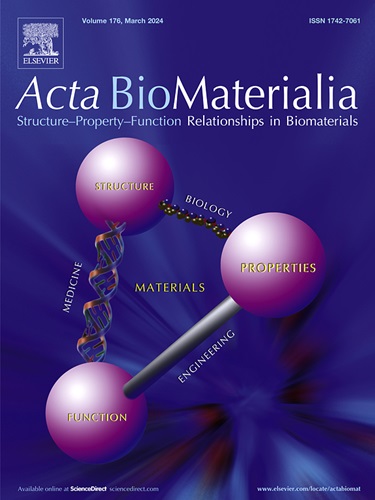骨肉瘤靶向PtIV前药两亲体通过Ca2+诱捕增强化学免疫治疗。
IF 9.4
1区 医学
Q1 ENGINEERING, BIOMEDICAL
引用次数: 0
摘要
基于铂(PtII)的抗癌药物在骨肉瘤治疗中缺乏选择性,导致显著的毒性。此外,肿瘤微环境中的免疫监视阻碍了骨肉瘤细胞对铂类药物的摄取。为了克服这些挑战,设计并合成了一种基于奥沙利铂的PtIV前药两亲性药物(lipoo - oxa -ALN),通过将靶向骨肉瘤的阿仑膦酸钠(ALN)与脂质尾部结合。脂质纳米颗粒(ALN-OXA)由脂质- oxa - aln自组装而成,由于其优越的Ca2+捕获能力,增强了细胞内铂的摄取,并显著抑制了骨肉瘤细胞的活性。此外,ALN-OXA表现出强大的靶向能力,有效抑制骨肉瘤生长,同时防止骨破坏。重要的是,ALN-OXA诱导了一系列免疫反应,其特征是免疫细胞的激活、树突状细胞的成熟和相关细胞因子的分泌,随后是T淋巴细胞的激活和浸润,细胞毒性T细胞的比例显著增加。此外,ALN-OXA治疗后,M1/M2巨噬细胞比例显著增加,提示ALN-OXA可能对肿瘤微环境进行重编程。总的来说,骨肉瘤治疗效果的提高表明PtIV前药两亲性药物代表了一种有希望的靶向化疗与旨在逆转免疫抑制的策略相结合的策略。意义声明:基于铂(PtII)的骨肉瘤化疗由于肿瘤选择性差而面临挑战,导致疗效不佳和毒性增加。此外,骨肉瘤微环境阻碍了有效的药物递送。为了克服这些限制,我们开发了一种基于奥沙利铂的PtIV前药纳米颗粒(ALN-OXA)用于靶向化学免疫治疗。ALN-OXA在体内表现出显著的疗效,可有效预防骨损伤,增强免疫微环境,改善治疗效果。这种创新的方法不仅能更有效地靶向肿瘤,还能增强免疫反应,为骨肉瘤的肿瘤阻断、肿瘤饥饿和其他治疗应用提供了一种有前途的策略。本文章由计算机程序翻译,如有差异,请以英文原文为准。

Osteosarcoma-targeting PtIV prodrug amphiphile for enhanced chemo-immunotherapy via Ca2+ trapping
Platinum (PtII)-based anticancer agents exhibit a lack of selectivity in the treatment of osteosarcoma, resulting in significant toxicity. Furthermore, immune surveillance withinthe tumor microenvironment impedes the uptake of platinum drugs by osteosarcoma cells. To overcome these challenges, an oxaliplatin-based PtIV prodrug amphiphile (Lipo-OXA-ALN) was designed and synthesized by incorporatingan osteosarcoma-targeting alendronate (ALN) alongside a lipid tail. The lipid nanoparticles (ALN-OXA), which self-assemble from Lipo-OXA-ALN, enhanced intracellular platinum uptake due to their superior Ca2+ trapping ability and significantly inhibit osteosarcoma cell activity. Moreover, ALN-OXA exhibited potent targeting capabilities, effectively suppressing osteosarcoma growth while preventing bone destruction. Importantly, ALN-OXA induces a series of immune responses characterized by the activation of immune cells, maturation of dendritic cells, and secretion of related cytokines, followed by the activation and infiltration of T lymphocytes and a significant increase in the ratio of cytotoxic T cells. Additionally, the ratio of M1/M2 macrophages increased markedly after ALN-OXA treatment, suggesting potential reprogramming of the tumor microenvironment by ALN-OXA. Overall, the improved therapeutic efficacy against osteosarcoma demonstrates that the PtIV prodrug amphiphile represents a promising strategy for combining targeted chemotherapy with strategies aimed at reversing immune suppression.
Statement of significance
Platinum (PtII)-based chemotherapy for osteosarcoma faces challenges due to poor tumor selectivity, leading to suboptimal efficacy and increased toxicity. Additionally, the osteosarcoma microenvironment impedes effective drug delivery. To overcome these limitations, we developed an oxaliplatin-based PtIV prodrug nanoparticle (ALN-OXA) for targeted chemo-immunotherapy. ALN-OXA showed significant in vivo efficacy, effectively preventing bone damage and enhancing the immune microenvironment to improve treatment outcomes. This innovative approach not only targets the tumor more efficiently but also boosts immune response, offering a promising strategy for tumor blockade, tumor starvation, and other therapeutic applications in osteosarcoma treatment.
求助全文
通过发布文献求助,成功后即可免费获取论文全文。
去求助
来源期刊

Acta Biomaterialia
工程技术-材料科学:生物材料
CiteScore
16.80
自引率
3.10%
发文量
776
审稿时长
30 days
期刊介绍:
Acta Biomaterialia is a monthly peer-reviewed scientific journal published by Elsevier. The journal was established in January 2005. The editor-in-chief is W.R. Wagner (University of Pittsburgh). The journal covers research in biomaterials science, including the interrelationship of biomaterial structure and function from macroscale to nanoscale. Topical coverage includes biomedical and biocompatible materials.
 求助内容:
求助内容: 应助结果提醒方式:
应助结果提醒方式:


